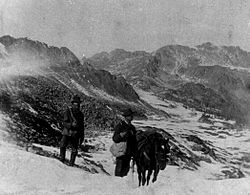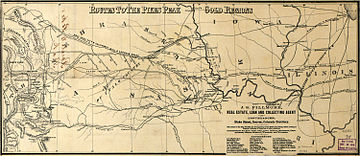- Pike's Peak Gold Rush
-
The Pike's Peak Gold Rush (later known as the Colorado Gold Rush) was the boom in gold prospecting and mining in the Pike's Peak Country of western Kansas Territory and southwestern Nebraska Territory of the United States that began in July 1858 and lasted until roughly the creation of the Colorado Territory on February 28, 1861. An estimated 100,000 gold seekers took part in one of the greatest gold rushes in North American history.[1] The participants in the gold rush were known as "Fifty-Niners" after 1859, the peak year of the rush and often used the motto Pike's Peak or Bust!
Contents
Overview
The Pike's Peak Gold Rush, which followed the California Gold Rush by approximately one decade, produced a dramatic but temporary influx of immigrants into the Pike's Peak Country of the Southern Rocky Mountains. The rush was exemplified by the slogan "Pike's Peak or Bust!", a reference to the prominent mountain at the eastern edge of the Rocky Mountains that guided many early prospectors to the region westward over the Great Plains. The prospectors provided the first major European-American population in the region. The rush created a few mining camps such as Denver City and Boulder City that would develop into cities. Many smaller camps such as Auraria and Saint Charles City were absorbed by larger camps and towns. Scores of other mining camps have faded into ghost towns, but quite a few camps such as Central City, Black Hawk, Georgetown, and Idaho Springs survive.
Discovery
In 1849 and 1850, several parties of gold seekers bound for the California Gold Rush panned small amounts of gold from various streams in the South Platte River Valley at the foot of the Rocky Mountains. The Rocky Mountain gold failed to impress or delay men with visions of unlimited wealth in California, and the discoveries were not reported for several years.[2]
As the hysteria of the California Gold Rush faded, many discouraged gold seekers returned home. Rumors of gold in the Rocky Mountains persisted and several small parties explored the region. In the summer of 1857, a party of Spanish-speaking gold seekers from New Mexico worked a placer deposit along the South Platte River about 5 miles (8 kilometers) above Cherry Creek in what is today Denver.[1]
William Greeneberry "Green" Russell was a Georgian who worked in the California gold fields in the 1850s. Russell was married to a Cherokee woman, and through his connections to the tribe, he heard about an 1849 discovery of gold along the South Platte River. Green Russell organized a party to prospect along the South Platte River, setting off with his two brothers and six companions in February 1858. They rendezvoused with Cherokee tribe members along the Arkansas River in present-day Oklahoma and continued westward along the Santa Fe Trail. Others joined the party along the way until their number reached 107.[2]
Upon reaching Bent's Fort, they turned to the northwest, reaching the confluence of Cherry Creek and the South Platte on May 23. The site of their initial explorations is in present-day Confluence Park in Denver. They began prospecting in the river beds, exploring Cherry Creek and nearby Ralston Creek but without success. In the first week of July 1858, Green Russell and Sam Bates found a small placer deposit near the mouth of Little Dry Creek that yielded about 20 troy ounces (622 grams) of gold, the first significant gold discovery in the Rocky Mountain region. The site of the discovery is in the present-day Denver suburb of Englewood, just north of the junction of U.S. Highway 285 and U.S. Highway 85.[2]
Gold rush
When word got back east, the Pike's Peak Gold Rush was on. By the winter of 1859, large numbers of prospective miners and settlers had come across the Great Plains to the Cherry Creek Diggings at the present site of Denver. Snow in the mountains west of Denver prevented the bulk of the gold seekers from entering the mountains and most waited in the raw new settlements of Denver City, Arapahoe City, Auraria, and Golden City for spring.
Rich placers and lodes discovered in the mountains
Main article: Gold mining in ColoradoOn January 7, 1859, prospector George A. Jackson discovered placer gold at the present site of Idaho Springs, where Chicago Creek empties into Clear Creek. It was the first substantial gold discovery in Colorado. Jackson, a Missouri native with experience in the California gold fields, was drawn to the area by clouds of steam rising from some nearby hot springs. Jackson kept his find secret for several months, but after he paid for some supplies with gold dust, others rushed to Jackson's diggings. The settlement was first called Spanish Bar, later renamed Idaho Springs, after the hot springs.[3]
In the spring of 1859 John H. Gregory, another experienced miner from Georgia who had participated in the California gold rush, made a major strike on the North Fork of Clear Creek at Gregory Gulch where he discovered rich placer deposits and staked out the first lode discovered in Colorado.[4] Many other discoveries followed at Central City, Black Hawk, and Nevadaville in Gregory Gulch and in nearby Russell Gulch.[5]
The initial boom
The first decade of the boom was largely concentrated along the South Platte River at the base of the mountains, the canyon of Clear Creek in the mountains west of Golden City, at Breckenridge and in South Park at Como, Fairplay, and Alma. By 1860, Denver City, Golden City, and Boulder City were substantial towns serving the mines. Rapid population growth led to the creation of the Colorado Territory in 1861.
Free gold
Main article: Gold mining in ColoradoHardrock mining boomed for a few years, but then declined in the mid-1860s as the miners exhausted the shallow parts of the veins that contained free gold, and found that their amalgamation mills could not recover gold from the deeper sulfide ores.[6] This problem was eventually solved and gold and silver mining in Colorado became a major industry.
References
- ^ a b Thomas J. Noel (December 19, 2006). "Denver History - The Arapaho Camp" (ASP/HTML). Mile High City. City and County of Denver. http://www.denvergov.org/AboutDenver/history_narrative_1.asp. Retrieved December 19, 2006.
- ^ a b c Gehling, Richard (2006). "The Pike's Peak Gold Rush". The Pike's Peak Gold Rush. Richard Gehling. Archived from the original on 2006-02-15. http://web.archive.org/web/20060215083309/http://www.geocities.com/Heartland/Falls/2000/index.html. Retrieved December 19, 2006.
- ^ Robert L. Brown (1985) The Great Pikes Peak Gold Rush, Caldwell, Ida.: Caxton, p. 26–32.
- ^ Page 2 "WHO and WHERE WAS JOHN GREGORY?"
- ^ Paul K. Sims and others (1963) Economic Geology of the Central City District, Gilpin County, Colorado, US Geological Survey, Professional Paper 359, p. 7–8.
- ^ A. H. Koschman and M. H. Bergendahl (1968) Principal Gold-Producing Districts of the United States, US Geological Survey, Professional Paper 610, p.86.
American Old West TownsOthersProminent figuresLawmenOutlaws- Billy the Kid
- Black Bart
- Butch Cassidy
- Jesse James and the James-Younger Gang
- Tom Ketchum
- Joaquin Murrieta
- Soapy Smith
- Sundance Kid
- Wild Bunch
Native AmericansOthersTransport and trails Native Americans Folklore - Alma Massacre
- Battle of Fort Tularosa
- Boot Hill
- Dead man's hand
- Frisco Shootout
- Gunfight at the O.K. Corral
- Long Tom's treasure
- Montezuma's treasure
- One-room schoolhouse
- Pecos Bill
- Skeleton Canyon
- Western saloon
- Wild West Shows
Gold rushes - California Gold Rush
- Pike's Peak Gold Rush
- Klondike Gold Rush
Range wars and feuds Lists - Cowboys and cowgirls
- Gangs
- Gunfights
- Lawmen
- Mountain men
- Outlaws
Categories:- American gold rushes
- Pre-state history of Colorado
- Economy of Colorado
- Colorado Mining Boom
- Economic history of the United States
- Jefferson Territory
- Mining in Colorado
- Pikes Peak
- Kansas Territory
Wikimedia Foundation. 2010.


